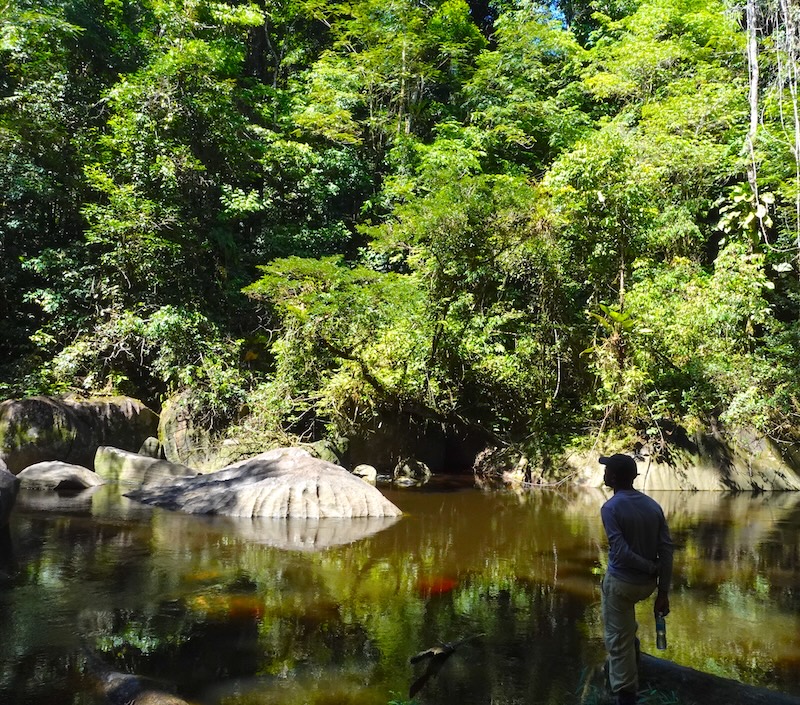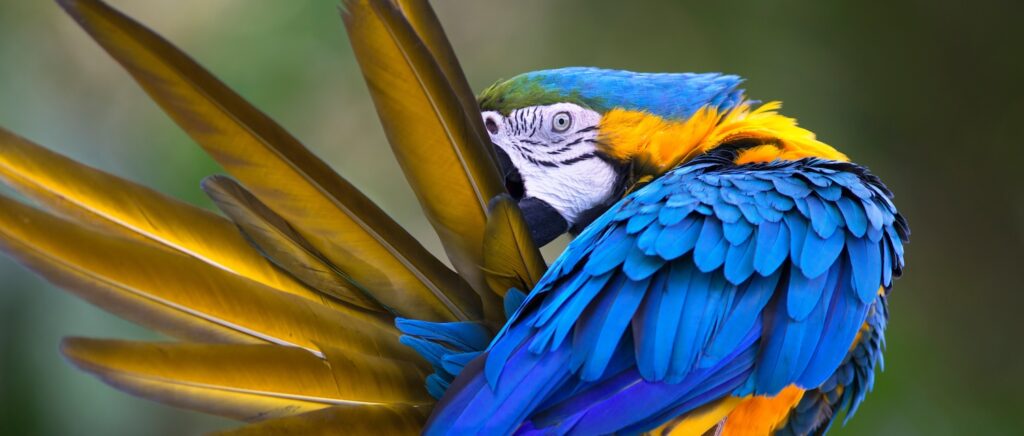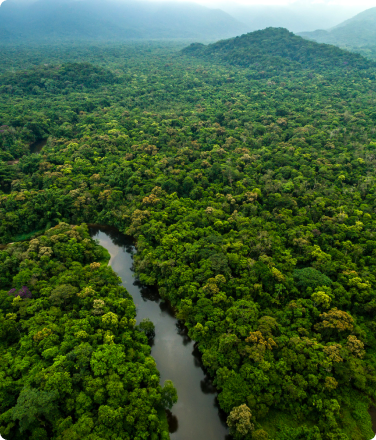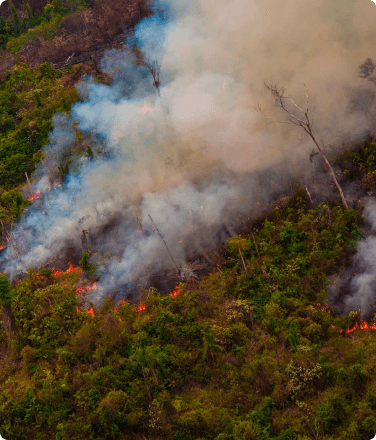- COP16, the U.N. Biodiversity Conference, is a critical moment for countries to turn biodiversity commitments into action.
- Any plans to protect biodiversity must include securing the rights of Indigenous peoples and local communities who directly depend on these lands.
- RFUS supports rights-based conservation by securing land tenure and protecting biodiversity.
Ecosystems and wildlife are disappearing at an unsettling rate. In 2023 alone, the world lost the equivalent of 10 football fields’ worth of tropical forest every minute. [1] A new study, the 2024 Living Planet Report, reveals that global wildlife populations have declined by an average of 73% since 1970, with Latin America and the Caribbean seeing the most dramatic declines. [2]
From October 21 to November 1, Indigenous leaders, government representatives, scientists, and activists will meet at the 16th Conference of the Parties Biodiversity Conference (COP16) in Cali, Colombia, where discussions on plans to expand protected area coverage are expected to take center stage.
Global leaders face a pivotal moment: Will they fulfill their commitments to protect biodiversity and people, or will they let our planet’s health continue to deteriorate, putting the future of our planet and its people at risk?
Why COP16 Matters: A Critical Moment for Biodiversity
COP16 marks a crucial checkpoint in the fight to halt biodiversity loss. It is the first meeting since the Kunming-Montreal Global Biodiversity Framework was adopted in 2022, where countries pledged to protect 30% of the world’s land and water and restore 30% of degraded ecosystems by 2030. The success of this framework—often referred to as the “30×30” goals—will be central to discussions in Cali.
But while the world made promises, there are still major gaps. As of October 2024, only 31 of 195 countries have met the deadline to publish National Biodiversity Strategies and Action Plans (NBSAPs) ahead of COP16.[3] Without robust strategies, financial commitments, concrete actions, and meaningful inclusion of Indigenous peoples, the 30×30 pledge risks becoming an empty slogan.
Moreover, challenges around financing and implementation persist. There is currently a $700 billion annual gap between available funding and what’s needed to protect and restore ecosystems. The lack of coordination between climate and biodiversity policies, insufficient attention to Indigenous peoples’ rights, and increasing pressure from extractive industries like mining, logging, and industrial fishing are all significant barriers to achieving global biodiversity goals.
Indigenous Peoples’ Land Rights: The Missing Piece to Achieving 30×30

The 30×30 target must recognize and protect Indigenous peoples’ land tenure rights.Their territories are some of the most biodiverse regions on the planet, and acknowledging their rights to these lands would increase the area recognized as Indigenous-managed by 63% to 98%. [4] This approach not only supports biodiversity but also strengthens local economies and resilience against climate change impacts.
Indigenous Peoples and Local Communities have long been effective stewards of their lands. Their traditional knowledge and management practices have safeguarded ecosystems that play a critical role in combating climate change and sustaining biodiversity. A recent article in Nature highlighted the fact that Indigenous peoples’ lands include more than one-third of the world’s intact forest landscapes (forest ecosystems that show little sign of habitat conversion or fragmentation). In addition, close to 60% of all terrestrial mammals for which reliable habitat data exist (comprising more than 2,500 species) have more than 10% of their ranges in Indigenous peoples’ lands. The article added that compared with protected areas, Indigenous peoples’ lands support at least as many species (when matched for habitat type, location, etc) and retained a similar proportion of habitat.[5] When their land rights are recognized, Indigenous peoples are able to protect these ecosystems from deforestation and degradation at rates significantly higher than government-managed protected areas.
Conversely, ignoring these rights risks undermining conservation efforts and sparking conflict. When conservation initiatives are imposed without proper consultation and respect for Indigenous sovereignty, it can lead to forced evictions, loss of livelihoods, and human rights abuses. At COP16, it is crucial for leaders to prioritize policies that integrate Indigenous peoples’ land rights with national biodiversity strategies and action plans. Doing so will ensure that these efforts are both equitable and effective, amplifying Indigenous contributions to the global 30×30 target.
What Needs to Happen at COP16
1. Recognize Indigenous Peoples’ Land Rights
Securing Indigenous land tenure is fundamental to protecting biodiversity. Governments must legally recognize and protect Indigenous peoples’ territories, ensuring that traditional governance systems are respected, community-driven titling is supported, and these efforts are integrated into national biodiversity strategies.
2. Increase Direct Funding for Indigenous and Local Communities’ Conservation Efforts
Establish direct channels to finance Indigenous Peoples and Local Communities’ initiatives, prioritizing land titling, community mapping, and Indigenous-led conservation strategies that safeguard critical ecosystems.
3. Align Policies with Community-Led Conservation Solutions
National biodiversity plans should incorporate traditional knowledge and prioritize locally-driven conservation strategies that reflect the needs and priorities of Indigenous Peoples and Local Communities.
4. Support Land Titling Programs
Expand and strengthen land titling initiatives in regions like the Amazon rainforest, where Rainforest Foundation US (RFUS) has successfully supported the recognition of millions of acres of Indigenous peoples’ territories, ensuring sustainable forest management and biodiversity protection.
5. Establish Transparent Monitoring and Accountability Mechanisms
Implement transparent, community-led monitoring systems to track biodiversity and land rights progress, ensuring that Indigenous voices are central in holding stakeholders accountable.
“The stakes at COP16 could not be higher. The decisions made in Cali will set the trajectory for the future of the world’s biodiversity and climate. It is imperative that world leaders go beyond rhetoric and take bold, meaningful actions to protect nature and ensure a livable planet for generations to come. Rainforest Foundation US stands firm in our belief that it is possible to achieve a future where people and nature thrive—but only if countries rise to the occasion. It’s time for true leadership, backed by concrete actions and an unwavering commitment to protect the diversity of life that sustains us all.
• Suzanne Pelletier, Executive Director of RFUS •”

Rainforest Foundation US’s Contribution to Biodiversity Protection
RFUS’s efforts to support Indigenous peoples’ land rights and strengthen local governance in key rainforest regions are integral to protecting biodiversity. Through partnerships with Indigenous organizations and communities, RFUS has helped secure legal recognition for 42 million acres of rainforest (an area nearly the size of Florida) since its founding, supporting communities to protect these ecosystems from deforestation and degradation. By ensuring land tenure rights and providing technical and financial support, RFUS is enhancing Indigenous peoples’ ability to manage their territories, promote sustainable land use, and maintain biodiversity. This approach not only protects critical habitats but also strengthens the resilience of these communities in the face of climate change and other environmental challenges.
RFUS Agenda at COP16
Forest Management 2.0: Innovation and Application
Date & Time: 26th October 2024,11:15 – 11:40 (COT)
Venue: Museo La Tertulia, Oeste, Cra. 1 #5-105, Cali, Valle del Cauca, Colombia
Notes
- World Resources Institute (WRI). Forest Pulse: The Latest on the World’s Forests. April, 2024.
- World Wild Fund (WWF). Living Planet Report (LPR) 2024.
- These include key nations like Australia, China, Indonesia, Malaysia, and Mexico. EU countries submitted their collective NBSAP through the European Union, while some individual EU members, like France and Spain, submitted separate plans. However, major biodiversity-rich countries such as Brazil, Colombia, Peru, and the Democratic Republic of the Congo missed the deadline. Read more at Carbon Brief. COP16: More than 85% of countries miss UN deadline to submit nature pledges
- Waldron, A. et al. Protecting 30% of the planet for nature: costs, benefits and economic implications. December 2020
- Fernandez Llamazares, A. et al. No basis for claim that 80% of biodiversity is found in Indigenous territories



